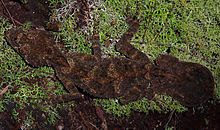Saltuarius swaini
This article needs additional citations for verification. (January 2009) |
| Saltuarius swaini | |
|---|---|

| |
| Scientific classification | |
| Domain: | Eukaryota |
| Kingdom: | Animalia |
| Phylum: | Chordata |
| Class: | Reptilia |
| Order: | Squamata |
| Family: | Carphodactylidae |
| Genus: | Saltuarius |
| Species: | S. swaini
|
| Binomial name | |
| Saltuarius swaini Wells & Wellington, 1985
| |
Saltuarius swaini, also known as the southern leaf-tailed gecko or Border Ranges leaf-tailed gecko is endemic to Australia[2] where it is found in coastal mountain ranges of southeastern Queensland and northern New South Wales.[3] It inhabits rainforests[3] and lives inside large tree root systems and hollows of strangler figs.[4] Its scientific name is after Malcolm Swain of the NSW National Parks & Wildlife Service.[2][3]
Description
Southern leaf tailed geckos are a light to dark brown colour with darker patterns.[4] The gecko is approx. 134 mm (5.3 in) long from snout to vent.[3]
Their tails are broad and leaf-life hence their common name.[5] When threatened or caught geckos can drop their tail to confuse predators. Eventually a new tail will be regenerated, although only the original tail will have the tubercules and matching colour and pattern to the torso; new tails will be very different in both colour and pattern.[4]
Life cycle
Female southern leaf-tailed geckos usually lay one or two soft-shelled eggs in late spring. These eggs are up to 28 mm in length. The eggs are buried in moist soil or leaf litter to prevent their drying out. Left to develop unattended, 3 months later the offspring hatch and begin fending for themselves, catching insects within only a few days of birth. They take up to two years to fully mature and then can survive for up to eight more years.[citation needed]
Diet
The southern leaf-tailed gecko eats mostly insects.[citation needed]
References
- ^ "Southern Leaf-tailed Gecko". IUCN Red List of Threatened Species: e.T56798733A56798771.
- ^ a b "Saltuarius swaini". The Reptile Database. Retrieved 2017-11-11.
- ^ a b c d "Saltuarius swaini". The Queensland Museum. Archived from the original on 27 December 2012. Retrieved 2017-11-11.
- ^ a b c Couper, Patrick J.; Sadlier, Ross A.; Shea, Glenn M.; Worthington Wilmer, Jessica (2008). "A Reassessment of 'Saltuarius swaini' (Lacertilia: Diplodactylidae) in Southeastern Queensland and New South Wales; Two New Taxa, Phylogeny, Biogeography and Conservation" (PDF). Records of the Australian Museum. 60: 87–118. doi:10.3853/j.0067-1975.60.2008.1492.
- ^ "Licked clean!". Australian Geographic. 2016-03-02. Retrieved 2024-06-22.

